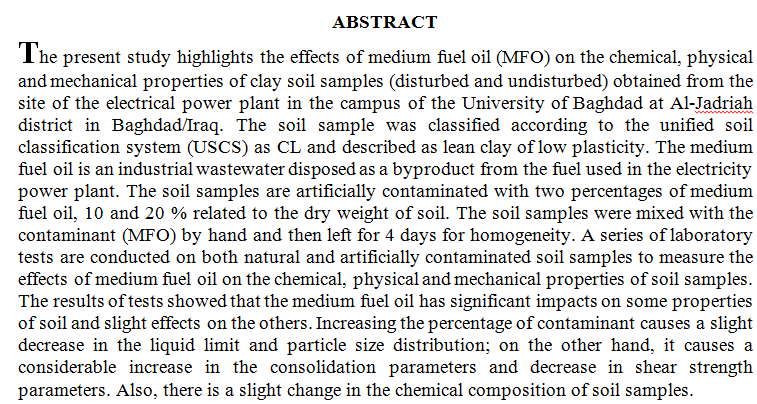
Contemporary residential neighborhoods suffer from weak sustainability of urban residential environments as a result of the adoption of inefficient spatial organization at the neighborhood unit level. This resulted negative characteristics which affected the achievement of sustainable development plans for the residential environment that constitute the majority of the urban fabric of cities.
The physical affordances ,within the vocabulary of recent times,overcame the spiritual ones and affected the residential environment. Accordingly,the concept of space changed in contemporary residential areas through the dominance of the physical aspect (mass) on the symbolic aspect (space).The modern technology occupied an important level b
... Show More (3)
(3)
Nigella sativa seeds (NSS) are reputed traditionally and scientifically as a potent agent that promote milk secretion (galactagogue), but their mechanism of action is studied trivially. One suggestion was that these seeds are bio-transformed to sex hormones within the ovaries. Therefore, this investigation was designated to throw light on the action of these seeds in the absence of ovaries i.e. in male rats. Thirty Norway male albino rats were used in this investigation. They were divided into experimental (n=20,fed NSS 2g/ Kg body weight /day for 14 days) and control (n=10, fed placebo for 14 days). After sacrifice mammary gland and blood samples were obtained. Experimental rats revealed a significant increase (p (0.01>in
... Show MoreThe research aims to investigate the possibility of joint auditing in improving the market value of Iraqi companies listed on the Iraq Stock Exchange. The sample was represented by 10 Iraqi companies listed in the Iraq market for the period from 2014-2017 (2 years before implementation and 2 years after implementation) and the research was based on the idea that joint auditing enhances investor confidence and raises their level of security as a result of providing quality and reliable reports, and thus This indicates good news in the market that reflects on the performance of stocks and the market value of companies that adopt joint auditing. The results of the analysis indicate an improvement in the market value, but this improv
... Show More (2)
(2)
The x-ray fluorescence (XRF) of Znpc molecule with (flow of Ar) and Znpc molecule with (grow in N2) showed two peaks at (8.5and 9.5 Kv) referring to orbital transition ) K?-shell & K?-shell) respectively. The study of x-ray diffraction (XRD) where it was observed good growth of the crystal structure as a needle by the sublimation technique with a ?-phase of (monoclinic structure ) . Using Bragg equation the value of the interdistance of the crystalline plane (d-value) were calculated. We noticed good similarity with like once in the American Standards for Testing Material (ASTM) .Powder Diffraction File (PDF) Program was used to ensure the information obtained from (ASTM) . The output of (PDF) was compared with celn program, where the val
... Show Morehe paper presents the results of exposure of normal concrete to high temperatures (400 and 700°C). In addition to the exposure of steel reinforcement bar Ø 12 mm, where two types of steel reinforcement burning situations were performed. Directly exposed to high temperatures (400 and 700°C) and others were covered by concrete layer (15 mm). From the experimental results of fire exposure for 1 hour of 400 and 700°C and gradually cooled, it was found that the residual average percentage of compressive strength of concrete was 85.3 and 41.4%, while the residual average percentage of modulus of elasticity of concrete was 75 and 48%, respectively. The residual average percentage of yielding tensile stress (Ø 12 mm) after burning and cooling
... Show More (5)
(5)
 (4)
(4)
 (9)
(9)
 (4)
(4)
This paper presents the thermophysical properties of zinc oxide nanofluid that have been measured for experimental investigation. The main contribution of this study is to define the heat transfer characteristics of nanofluids. The measuring of these properties was carried out within a range of temperatures from 25 °C to 45 °C, volume fraction from 1 to 2 %, and the average nanoparticle diameter size is 25 nm, and the base fluid is water. The thermophysical properties, including viscosity and thermal conductivity, were measured by using Brookfield rotational Viscometer and Thermal Properties Analyzer, respectively. The result indicates that the thermophysical properties of zinc oxide nanofluid increasing with nanoparticle volume f
... Show More (3)
(3)
 (2)
(2)
structural and electrical of CuIn (Sex Te1-x)2
Background: This study aimed to compare the mechanical properties between four groups of newly fabricated combination wires according to their method of union, according to the gauges of wires and a comparison were made between them and their originals. Materials and method: A total of 60 stainless steel combination wires were fabricated , divided into four groups according to gauge of wires and their method of union, each of them with 15 samples, the groups were welded (0.016x0.022-0.016 and 0.016x0.022-0.018) and soldered (0.016x0.022-0.016 and 0.016x0.022-0.018), samples were made according to certain parameters which were : for the welded samples: length,weight, duration of pulsation and size of copper electrode tips used; for the sold
... Show More